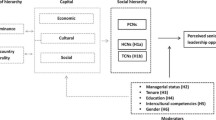Abstract
Korea is a society subject to quite diverse social forces. Modernization “should” encourage reform, but the yoke of tradition restrains this tendency. This paper examines the patterns of preferential treatment of executives, based on family, school, and regional ties, by the owners of large “Jaebol” corporations in Korea. We found that about 21% of the total number of executive positions in the large corporations were occupied by individuals who had some type of “family tie” with the owners of the corporations. Also, there is a strong tendency of corporation owners to employ the executives of the same regional origin of birth as their own, but the affinity based on school ties was not as strong as that of regional origin. The findings of this study seem to support the arguments of previous studies that claimed a “trust” factor as a main cause of social similarity and affinity between the owners and executives in corporations.
Similar content being viewed by others
References
Arrow, Kenneth J. 1969 “The organization of economic activity: Issues pertinent of the choice of market versus nonmarket allocation.” In the Analysis and Evaluation of Public Expenditures: The PPB System, Vol. 1. Joint Economic Committee, 91st Congress., 1st Session: 47–63.
Ben-Porath, Yoram 1980 “The f-connection: Families, friends, and firms and the organization of exchange.” Population and Development Review 6:1–30.
Bourdieu, Pierre andJean-Claude Passeron 1977 Reproduction in Education, Society and Culture. London: Sage Publications.
Brewer, Marilyn B. andDonald T. Campbell 1976 Ethnocentrism and Intergroup Attitudes: East African Evidence. New York: John Wiley.
Choi, Jae-Suk 1983 Social Characteristics of Korean People. Seoul, Korea: Gae-Moon Sa.
Collins, Randall 1975 Conflict Sociology: Toward an Explanatory Science. New York: Academic Press.
Cookson, Peter W., Jr., andCaroline H. Persell 1985 Preparing for Power: America's Elite Boarding Schools. New York: Basic Books.
Davis, Kingsley 1950 Human Society. New York: Macmillan.
Duncan, Otis Dudley 1979 “How destination depends on origin in the occupational mobility table.” American Journal of Sociology 84:793–803.
Granovetter, Mark S. 1973 “The strength of weak ties.” American Journal of Sociology 78:1360–1380.
Haberman, S. J. 1979 Analysis of Qualitative Data. New York: Academic Press.
Harbison, Frederick andCharles A. Myers 1959 Management in the Industrial World. New York: McGraw-Hill.
Hattori, Tamio 1982 “The stock holding patterns on Korean ‘zaibatsu’ with special reference to the stock holding and family structure.” The Social Science 30:122–169.
Homans, Geroge C. 1950 The Human Group. New York: Harcourt, Brace and World, Inc.
Hout, Michael 1983 Mobility Tables. Beverly Hills, CA: Sage Publications.
Johnson, Charlmers 1987 “Political institutions and economic performance: The government-business relationship in Japan, South Korea and Taiwan.” In F. Deyo (ed.), The Political Economy of the New Asian Industrialism: 136–164. Ithaca, NY: Cornell University Press.
Jones, Leroy P. andIl Sakong 1980 Government, Business, and Entrepreneurship in Economic Development: The Korean Case. Cambridge, MA: Harvard University Press.
Kaelble, Harmut 1980 “Long-term changes in the recruitment of the business elite: Germany compared to the U.S., Great Britain, and France since the Industrial Revolution.” Journal of Social History 13:404–423.
Kanter, Rosabeth Moss 1977 Men and Women of the Corporation. New York: Basic Books.
Khalaf, Samir andEmilie Shawayri 1966 “Family firms and industrial development: The Lebanese case.” Economic Development and Cultural Change 15:59–69.
Levine, Robert A. andDonald T. Campbell 1972 Ethnocentrism: Theories of Conflict, Ethnic Attitudes and Group Behavior. New York: John Wiley.
Levine, Steven B. 1980 “The rise of American boarding schools and the development of a national upper class.” Social Problems 28:63–93.
Lim, Young-il 1981 “Government and private enterprise: Korean experience in industralization.” Korean Research Monograph No. 6, Institute of East Asian Studies, University of California, Berkeley.
Marsden, Peter V. 1981 “Models and methods for characterizing the structural parameters of groups.” Social Networks 3:1–27.
Mason, Edwards S., Mahn Je Kim, Dwight H. Perkins, Kwang Suk Kim, andDavid C. Cole 1980 The Economic and Social Modernization of the Republic of Korea. Cambridge, MA: Harverd University Press.
Mayhew, Leon 1968 “Ascription in modern societies.” Sociological Inquiry 38:105–120.
Mills, C. Wright 1956 The Power Elite. New York: Oxford University Press.
Moon, Suk-Nam 1984 “Interregional disparities and conflict: Focused on the Youngnam and Honam Regions.” Hanguk Sahoehak 18:184–209.
Moore, Wilbert 1962 The Conduct of the Corporation. New York: Vintage.
Omohundro, John T. 1981 Chinese Merchant Families in Iloilo: Commerce and Kin in a Central Phillipine City. Athens, OH: Ohio University Press.
Parsons, Talcott 1951 The Social System. Glencoe, IL: The Free Press.
Savage, Dean 1979 Founders, Heirs, and Managers: French Industrial Leadership in Transition. Beverly Hills, CA: Sage Publications.
Scott, John F. 1972 “Ascription and mobility.” In Gerald W. Theilbar and Saul D. Feldman (eds.), Issues in Social Inequality: 580–597. Boston: Little, Brown.
Sobel, Michael, E., Michael Hout, andOtis Dudley Duncan 1985 “Exchange, structure, and symmetry in occupational mobility.” American Journal of Sociology 91:359–372.
Taira, Koji andTeiichi Wada 1987 “Business-government relations in modern Japan: A todai-yakkai-zaikai complex?” In Mark S. Mizruchi and Michael Schwartz (eds.), Intercorporate Relations: The Structural Analysis of Business: 264–297. New York: Cambridge University Press.
1979 “The social organization of the American business elite.” American Sociological Review 44:553–571.
1984 The Inner Circle: Large Corporations and the Rise of Business Political Activity in the U.S. and U.K. New York: Oxford University Press.
Useem, Michael andJerome Karabel 1986 “Pathways to top corporate management.” American Sociological Review 51:184–200.
Wong, Siu-lun 1985 “The Chinese family firm: A model.” British Journal of Sociology 36:58–72.
Author information
Authors and Affiliations
Additional information
An earlier version of this paper was presented at the annual meetings of the American Sociological Association, August 17–22, 1987, Chicago, Illinois.
Rights and permissions
About this article
Cite this article
Shin, E.H., Chin, S.K. Social affinity among top managerial executives of large corporations in Korea. Sociol Forum 4, 3–26 (1989). https://doi.org/10.1007/BF01112614
Issue Date:
DOI: https://doi.org/10.1007/BF01112614




